formerly eScholarship Editions


|
|
|
|
Your request for similar items found 20 book(s). | Modify Search | Displaying 1 - 20 of 20 book(s) | |
| 1. | 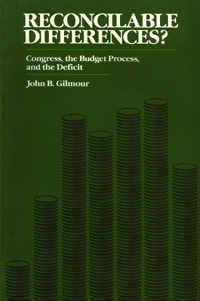 | Title: Reconcilable differences?: congress, the budget process, and the deficit Author: Gilmour, John B Published: University of California Press, 1990 Subjects: Politics | Economics and Business | Public Policy Publisher's Description: Gilmour traces the development of the congressional budget process from its origin through the emergence of reconcilliation and Gramm-Rudman-Hollings. He shows how changes in process have brought about far-reaching shifts in congressional power, and explains why they have failed to control the explosion of budget deficits.Throughout the last decade budgetary issues have dominated the national political agenda as the deficit has skyrocketed to previously unimaginable levels. In this important book, John Gilmour traces the continuing quest of Congress over the last fifteen years to reform its budgeting system in the hope of producing better policy. He shows that the enactment of the Congressional Budget Act of 1974 and the introduction of the reconciliation procedure in 1980 have produced a budgetary system in which congressional majorities can get what they want, provided only that they can agree on a comprehensive budget policy. From his thorough analysis, Gilmour concludes that, while the reforms have not produced balanced budgets, they have eliminated procedural obstructions to the adoption of a coherent budget.New budget procedures have transformed the way Congress works. Before the reforms of 1974 and 1980, Congress had an extremely fragmented, disintegrated budgetary system in which the budget emerged almost haphazardly from the independent actions of numerous committees. Gilmour shows that reconciliation procedures in the budget process makes total revenue, total expenditures, and the size of the deficit matters of deliberate choice, consolidating decisionmaking to an extent unprecedented in the history of the modern Congress.Yet, despite the striking structural and procedural changes, and despite its highly majoritarian features, the budget process has failed to reduce dissatisfaction with congressional handling of money. Deficits have been larger, not smaller, and overall spending has gone up. Gilmour deftly shows that the massive budget deficits of the Reagan years were due primarily to the failure of the House, the Senate, and the President to agree on how to reduce spending or increase taxes enough to eliminate the deficit. Responsibility for budgetary failure, he argues, must rest with Congress and its inability to reach consensus, not on the new budget process, which, given what we can expect from procedural change, has been quite successful. [brief] Similar Items |
| 2. |  | Title: Creating the Cold War university: the transformation of Stanford Author: Lowen, Rebecca S 1959- Published: University of California Press, 1997 Subjects: History | Education | Technology and Society | Military History | Californian and Western History | History and Philosophy of Science | California and the West | Intellectual History | United States History | United States History Publisher's Description: The "cold war university" is the academic component of the military-industrial-academic complex, and its archetype, according to Rebecca Lowen, is Stanford University. Her book challenges the conventional wisdom that the post-World War II "multiversity" was created by military patrons on the one hand and academic scientists on the other and points instead to the crucial role played by university administrators in making their universities dependent upon military, foundation, and industrial patronage.Contesting the view that the "federal grant university" originated with the outpouring of federal support for science after the war, Lowen shows how the Depression had put financial pressure on universities and pushed administrators to seek new modes of funding. She also details the ways that Stanford administrators transformed their institution to attract patronage.With the end of the cold war and the tightening of federal budgets, universities again face pressures not unlike those of the 1930s. Lowen's analysis of how the university became dependent on the State is essential reading for anyone concerned about the future of higher education in the post-cold war era. [brief] Similar Items |
| 3. |  | Title: Michelangelo's Last Judgment: the Renaissance response Author: Barnes, Bernadine Ann Published: University of California Press, 1998 Subjects: Art Publisher's Description: In her analysis of Michelangelo's Last Judgment , Bernadine Barnes provides an original and stimulating view of this renowned fresco and of the audience for which it was created. Because Michelangelo is so often regarded as a nearly superhuman artistic genius, we tend to forget that his works were not created to illustrate his life. The Last Judgment did have great personal meaning for him, but his representation of this religious event was not purely self-directed, says Barnes. She argues that Michelangelo had a particular type of viewer in mind as he designed his work. The Last Judgment dealt with an especially evocative subject, and Michelangelo engaged viewers by creating highly imaginative scenes tempering fear with hope and by referring to contemporary events. The painting's original, elite audience - the papal court and a handful of distinguished lay persons - was sophisticated about art and poetry, almost exclusively male, and orthodox in its religious beliefs. That audience later broadened and included artists allowed into the Chapel to copy Michelangelo's work. These artists helped to create another, less sophisticated audience, one that knew the fresco only through reproductions and written descriptions. The response of this latter audience eventually prompted the church to censor the painting. Beautifully illustrated with photographs of the recently restored Sistine Chapel, Barnes's study greatly enhances our understanding of changing Renaissance attitudes toward art. Her book also provides valuable insights into one of Michelangelo's greatest works. [brief] Similar Items |
| 4. |  | Title: The last emperors: a social history of Qing imperial institutions Author: Rawski, Evelyn Sakakida Published: University of California Press, 1998 Subjects: History | Anthropology | China | Asian History Publisher's Description: The Qing Dynasty (1644-1911) was the last and arguably the greatest of the conquest dynasties to rule China. Its rulers, Manchus from the north, held power for three centuries despite major cultural and ideological differences with the Han majority. In this book, Evelyn Rawski offers a bold new interpretation of the remarkable success of this dynasty, arguing that it derived not from the assimilation of the dominant Chinese culture, as has previously been believed, but rather from an artful synthesis of Manchu leadership styles with Han Chinese policies. [brief] Similar Items |
| 5. |  | Title: Dangerous intimacy: the untold story of Mark Twain's final years Author: Lystra, Karen Published: University of California Press, 2004 Subjects: Literature | Autobiographies and Biographies | Twain | American Literature | American Studies Publisher's Description: The last phase of Mark Twain's life is sadly familiar: Crippled by losses and tragedies, America's greatest humorist sank into a deep and bitter depression. It is also wrong. This book recovers Twain's final years as they really were - lived in the shadow of deception and prejudice, but also in the light of the author's unflagging energy and enthusiasm. Dangerous Intimacy relates the story of how, shortly after his wife's death in 1904, Twain basked in the attentions of Isabel Lyon, his flirtatious - and calculating - secretary. Lyon desperately wanted to marry her boss, who was almost thirty years her senior. She managed to exile Twain's youngest daughter, Jean, who had epilepsy. With the help of Twain's assistant, Ralph Ashcroft, who fraudulently acquired power of attorney over the author's finances, Lyon nearly succeeded in assuming complete control over Twain's life and estate. Fortunately, Twain recognized the plot being woven around him just in time. So rife with twists and turns as to defy belief, the story nonetheless comes to undeniable, vibrant life in the letters and diaries of those who witnessed it firsthand: Katy the housekeeper, Jean, Lyon, and others whose own distinctive, perceptive, often amusing voices take us straight into the heart of the Clemens household. Just as Twain extricated himself from the lies, prejudice, and self-delusion that almost turned him into an American Lear, so Karen Lystra liberates the author's last decade from a century of popular misunderstanding. In this gripping book we at last see how, late in life, this American icon discovered a deep kinship with his youngest child and continued to explore the precarious balance of love and pain that is one of the trademarks of his work. [brief] Similar Items |
| 6. |  | Title: Speak, bird, speak again: Palestinian Arab folktales Author: Muhawi, Ibrahim 1937- Published: University of California Press, 1989 Subjects: Anthropology | Literature in Translation | Middle Eastern Studies | Folklore and Mythology Publisher's Description: Were it simply a collection of fascinating, previously unpublished folktales, Speak, Bird, Speak Again: Palestinian Arab Folktales would merit praise and attention because of its cultural rather than political approach to Palestinian studies. But it is much more than this. By combining their respective expertise in English literature and anthropology, Ibrahim Muhawi and Sharif Kanaana bring to these tales an integral method of study that unites a sensitivity to language with a deep appreciation for culture.As native Palestinians, the authors are well-suited to their task. Over the course of several years they collected tales in the regions of the Galilee, Gaza, and the West Bank, determining which were the most widely known and appreciated and selecting the ones that best represented the Palestinian Arab folk narrative tradition. Great care has been taken with the translations to maintain the original flavor, humor, and cultural nuances of tales that are at once earthy and whimsical. The authors have also provided footnotes, an international typology, a comprehensive motif index, and a thorough analytic guide to parallel tales in the larger Arab tradition in folk narrative. Speak, Bird, Speak Again is an essential guide to Palestinian culture and a must for those who want to deepen their understanding of a troubled, enduring people. [brief] Similar Items |
| 7. |  | Title: Returning cycles: contexts for the interpretation of Schubert's impromptus and last sonatas Author: Fisk, Charles Published: University of California Press, 2001 Subjects: Music | Musicology | Composers Publisher's Description: This compelling investigation of the later music of Franz Schubert explores the rich terrain of Schubert's impromptus and last piano sonatas. Drawing on the relationships between these pieces and Schubert's Winterreise song cycle, his earlier "Der Wanderer," the closely related "Unfinished" Symphony, and his story of exile and homecoming, "My Dream," Charles Fisk explains how Schubert's view of his own life may well have shaped his music in the years shortly before his death. Fisk's intimate portrayal of Schubert is based on evidence from the composer's own hand, both verbal (song texts and his written words) and musical (vocal and instrumental). Noting extraordinary aspects of tonality, structure, and gestural content, Fisk argues that through his music Schubert sought to alleviate his apparent sense of exile and his anticipation of early death. Fisk supports this view through close analyses of the cyclic connections within and between the works he explores, finding in them complex musical narratives that attempt to come to terms with mortality, alienation, hope, and desire. Fisk's knowledge of Schubert's life and music, together with his astute and imaginative attention to musical detail, helps him achieve one of the most difficult goals in music criticism: to capture and verbalize the human content of instrumental music. [brief] Similar Items |
| 8. |  | Title: Play it again, Sam: retakes on remakes Author: Horton, Andrew Published: University of California Press, 1998 Subjects: Cinema and Performance Arts | Film Publisher's Description: Play It Again, Sam is a timely investigation of a topic that until now has received almost no critical attention in film and cultural studies: the cinematic remake. As cinema enters its second century, more remakes are appearing than ever before, and these writers consider the full range: Hollywood films that have been recycled by Hollywood, such as The Jazz Singer, Cape Fear , and Robin Hood ; foreign films including Breathless ; and Three Men and a Baby , which Hollywood has reworked for American audiences; and foreign films based on American works, among them Yugoslav director Emir Kusturica's Time of the Gypsies , which is a "makeover" of Coppola's Godfather films. As these essays demonstrate, films are remade by other films (Alfred Hitchcock went so far as to remake his own The Man Who Knew Too Much ) and by other media as well.The editors and contributors draw upon narrative, film, and cultural theories, and consider gender, genre, and psychological issues, presenting the "remake" as a special artistic form of repetition with a difference and as a commercial product aimed at profits in the marketplace. The remake flourishes at the crossroads of the old and the new, the known and the unknown. Play It Again, Sam takes the reader on an eye-opening tour of this hitherto unexplored territory. [brief] Similar Items |
| 9. |  | Title: Reclaiming America: Nike, clean air, and the new national activism Author: Shaw, Randy 1956- Published: University of California Press, 1999 Subjects: American Studies | Politics | Public Policy Publisher's Description: Have activists taken the bumper-sticker adage "Think Globally, Act Locally" too literally? Randy Shaw argues that they have, with destructive consequences for America. Since the 1970s, activist participation in national struggles has steadily given way to a nearly exclusive focus on local issues. America's political and corporate elite has succeeded in controlling the national agenda, while their adversaries - the citizen activists and organizations who spent decades building federal programs to reflect the country's progressive ideals - increasingly bypass national fights. The result has been not only the dismantling of hard-won federal programs but also the sabotaging of local agendas and community instituions by decisions made in the national arena.Shaw urges activists and their organizations to implement a "new national activism" by channeling energy from closely knit local groups into broader causes. Such activism enables locally oriented activists to shape America's future and work on national fights without traveling to Washington, D.C., but instead working in their own backyards. Focusing on the David and Goliath struggle between Nike and grassroots activists critical of the company's overseas labor practices, Shaw shows how national activism can rewrite the supposedly ironclad rules of the global economy by ensuring fair wages and decent living standards for workers at home and abroad. Similarly, the recent struggles for stronger clean air standards and new federal budget priorities demonstrate the potential grassroots national activism to overcome the corporate and moneyed interests that increasingly dictate America's future. Reclaiming America's final section describes how community-based nonprofit organizations, the media, and the Internet are critical resources for building national activism. Shaw declares that community-based groups can and must combine their service work with national grassroots advocacy. He also describes how activists can use public relations to win attention in today's sprawling media environment, and he details the movement-building potential of e-mail. All these resources are essential for activists and their organizations to reclaim America's progressive ideals. [brief] Similar Items |
| 10. | 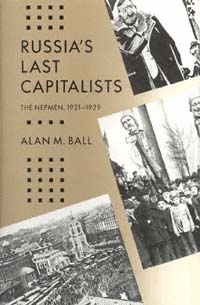 | Title: Russia's last capitalists: the Nepmen, 1921-1929 Author: Ball, Alan M Published: University of California Press, 1990 Subjects: History | European History | Russian and Eastern European Studies Publisher's Description: In 1921 Lenin surprised foreign observers and many in his own Party, by calling for the legalization of private trade and manufacturing. Within a matter of months, this New Economic Policy (NEP) spawned many thousands of private entrepreneurs, dubbed Nepmen. After delineating this political background, Alan Ball turns his attention to the Nepmen themselves, examining where they came from, how they fared in competition with the socialist sector of the economy, their importance in the Soviet economy, and the consequences of their "liquidation" at the end of the 1920s. Alan Ball's history of this experiment with capitalism is strikingly relevant to current efforts toward economic reform in the USSR. [brief] Similar Items |
| 11. |  | Title: The research universities and their patrons Author: Rosenzweig, Robert M Published: University of California Press, 1982 Subjects: Sociology | Sociology Similar Items |
| 12. | 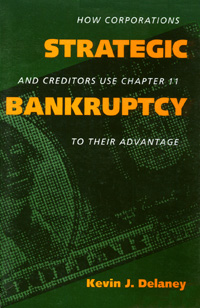 | Title: Strategic bankruptcy: how corporations and creditors use Chapter 11 to their advantage Author: Delaney, Kevin J 1960- Published: University of California Press, 1992 Subjects: Sociology | Public Policy | Economics and Business Publisher's Description: In 1982 Johns-Manville, a major asbestos manufacturer, declares itself insolvent to avoid paying claims resulting from exposure to its products. A year later, Continental Airlines, one of the top ten carriers in the United States, claims a deficit when the union resists plans to cut labor costs. Later still, oil powerhouse Texaco cries broke rather than pay damages resulting from a courtroom defeat by archrival Pennzoil.Bankruptcy, once a term that sent shudders up a manager's spine, has now become a potent weapon in the corporate arsenal. In his timely and challenging study, Kevin Delaney explores this profound change in our legal landscape, where corporations with billions of dollars in assets employ bankruptcy to achieve specific political and organizational objectives. As a consequence, bankruptcy court is rapidly becoming an arena in which crucial social issues are resolved: How and when will people dying of asbestos poisoning be compensated? Can companies unilaterally break legally negotiated labor contracts? What are the ethical and legal rules of the corporate takeover game?In probing the Chapter 11 bankruptcies of Johns-Manville, Frank Lorenzo's Continental Airlines, and Texaco, Delaney shows not only that bankruptcy is pursued by managers more and more as a strategy, but that it is becoming accepted by the business community as a viable option, and not just a last-ditch solution.This searing exposé of current corporate practices will incite debate among corporate executives, lawyers, legislators, and policy makers. [brief] Similar Items |
| 13. | 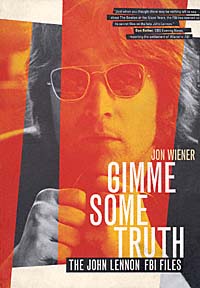 | Title: Gimme some truth: the John Lennon FBI files Author: Wiener, Jon Published: University of California Press, 2000 Subjects: American Studies | Politics | Sociology | Social Problems | Music | Social Theory | Cultural Anthropology | Law Publisher's Description: When FBI Director J. Edgar Hoover reported to the Nixon White House in 1972 about the Bureau's surveillance of John Lennon, he began by explaining that Lennon was a "former member of the Beatles singing group." When a copy of this letter arrived in response to Jon Wiener's 1981 Freedom of Information request, the entire text was withheld - along with almost 200 other pages - on the grounds that releasing it would endanger national security. This book tells the story of the author's remarkable fourteen-year court battle to win release of the Lennon files under the Freedom of Information Act in a case that went all the way to the Supreme Court. With the publication of Gimme Some Truth , 100 key pages of the Lennon FBI file are available - complete and unexpurgated, fully annotated and presented in a "before and after" format.Lennon's file was compiled in 1972, when the war in Vietnam was at its peak, when Nixon was facing reelection, and when the "clever Beatle" was living in New York and joining up with the New Left and the anti-war movement. The Nixon administration's efforts to "neutralize" Lennon are the subject of Lennon's file. The documents are reproduced in facsimile so that readers can see all the classification stamps, marginal notes, blacked out passages and - in some cases - the initials of J. Edgar Hoover. The file includes lengthy reports by confidential informants detailing the daily lives of anti-war activists, memos to the White House, transcripts of TV shows on which Lennon appeared, and a proposal that Lennon be arrested by local police on drug charges.Fascinating, engrossing, at points hilarious and absurd, Gimme Some Truth documents an era when rock music seemed to have real political force and when youth culture challenged the status quo in Washington. It also delineates the ways the Reagan, Bush, and Clinton administrations fought to preserve government secrecy, and highlights the legal strategies adopted by those who have challenged it. [brief] Similar Items |
| 14. | 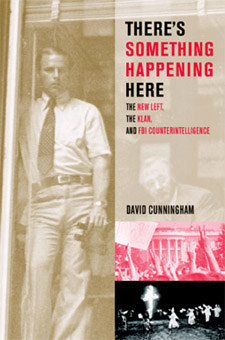 | Title: There's something happening here: the New Left, the Klan, and FBI counterintelligence Author: Cunningham, David 1970- Published: University of California Press, 2004 Subjects: American Studies | History | Politics | Sociology | Law Publisher's Description: Using over twelve thousand previously classified documents made available through the Freedom of Information Act, David Cunningham uncovers the riveting inside story of the FBI's attempts to neutralize political targets on both the Right and the Left during the 1960s. Examining the FBI's infamous counterintelligence programs (COINTELPROs) against suspected communists, civil rights and black power advocates, Klan adherents, and antiwar activists, he questions whether such actions were aberrations or are evidence of the bureau's ongoing mission to restrict citizens' right to engage in legal forms of political dissent. At a time of heightened concerns about domestic security, with the FBI's license to spy on U.S. citizens expanded to a historic degree, the question becomes an urgent one. This book supplies readers with insights and information vital to a meaningful assessment of the current situation. There's Something Happening Here looks inside the FBI's COINTELPROs against white hate groups and the New Left to explore how agents dealt with the hundreds of individuals and organizations labeled as subversive threats. Rather than reducing these activities to a product of the idiosyncratic concerns of longtime director J. Edgar Hoover, Cunningham focuses on the complex organizational dynamics that generated literally thousands of COINTELPRO actions. His account shows how--and why--the inner workings of the programs led to outcomes that often seemed to lack any overriding logic; it also examines the impact the bureau's massive campaign of repression had on its targets. The lessons of this era have considerable relevance today, and Cunningham extends his analysis to the FBI's often controversial recent actions to map the influence of the COINTELPRO legacy on contemporary debates over national security and civil liberties. [brief] Similar Items |
| 15. |  | Title: War stories: the search for a usable past in the Federal Republic of Germany Author: Moeller, Robert G Published: University of California Press, 2001 Subjects: History | European Studies | German Studies | European History Publisher's Description: Robert G. Moeller powerfully conveys the complicated story of how West Germans recast the recent past after the Second World War. He rejects earlier characterizations of a postwar West Germany dominated by attitudes of "forgetting" or silence about the Nazi past. He instead demonstrates the "selective remembering" that took place among West Germans during the postwar years: in particular, they remembered crimes committed against Germans, crimes that - according to some contemporary accounts - were comparable to the crimes of Germans against Jews. Moeller draws on a wide range of U.S. and German government documents, political debates, film archives, letters, oral histories, and newspaper accounts. [brief] Similar Items |
| 16. | 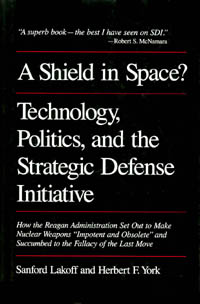 | Title: A shield in space?: technology, politics, and the strategic defense initiative: how the Reagan Administration set out to make nuclear weapons "impotent and obsolete" and succumbed to the fallacy of the last move Author: Lakoff, Sanford A Published: University of California Press, 1989 Subjects: Politics | Political Theory | Technology and Society Publisher's Description: In March 1983, Ronald Reagan made one of the most controversial announcements of his presidency when he called on the nation's scientists and engineers to develop a defensive shield so impenetrable as to make nuclear weapons "impotent and obsolete." This book provides the first comprehensive review and evaluation of the project launched to implement that announcement - the project officially known as the Strategic Defense Initiative and more popularly as "Star Wars." The authors - a political scientist and a physicist who has played a key role in developing military technologies - provide an intriguing account of how political rather than technical judgment led to the initial decision, and they explain the technical issues in terms accessible to nonspecialists. Judging SDI as "a classic example of misplaced faith in the promise of technological salvation," the authors examine the implications of the program for strategy, arms control, the unity of the Western alliance, its prospective economic impact, and the way the American political process has dealt with all these issues. [brief] Similar Items |
| 17. |  | Title: Big doctoring in America: profiles in primary care Author: Mullan, Fitzhugh Published: University of California Press, 2002 Subjects: Medicine | Health Care | Sociology Publisher's Description: The general practitioner was once America's doctor. The GP delivered babies, removed gallbladders, and sat by the bedsides of the dying. But as the twentieth century progressed, the pattern of medical care in the United States changed dramatically. By the 1960s, the GP was almost extinct. The later part of the twentieth century, however, saw a rebirth of the idea of the GP in the form of primary care practitioners. In this engrossing collection of oral histories and provocative essays about the past and future of generalism in health care, Fitzhugh Mullan - a pediatrician, writer, and historian - argues that primary care is a fascinating, important, and still endangered calling. In conveying the personal voices of primary care practitioners, Mullan sheds light on the political and economic contradictions that confront American medicine. Mullan interviewed dozens of primary care practitioners - family physicians, internists, pediatricians, nurse practitioners, and physician assistants - asking them about their lives and their work. He explains how, during the last forty years, the primary care movement has emerged built on the principles of "big doctoring"--coordinated, comprehensive care over time. This book is essential reading for understanding core issues of the current health care dilemma. As our country struggles with managed care, market reforms, and cost containment strategies in medicine, Big Doctoring in America provides an engrossing and illuminating look at those in the trenches of the profession. [brief] Similar Items |
| 18. |  | Title: Struggling with destiny in Karimpur, 1925-1984 Author: Wadley, Susan Snow 1943- Published: University of California Press, 1994 Subjects: Anthropology | Cultural Anthropology | South Asia | Asian History Publisher's Description: Susan Wadley first visited Karimpur - the village "behind mud walls" made famous by William and Charlotte Wiser - as a graduate student in 1967. She returned often, adding her observations and experiences to the Wisers' field notes from the 1920s and 1930s. In this long-awaited book, Wadley gives us a work of unprecedented scope: a portrait of an Indian village as it has changed over a sixty-year period.She hears of changes in agriculture, labor relations, education, and the family. But Karimpur's residents do not speak with one voice in describing the ways their lives have changed - viewpoints vary considerably depending on the speaker's gender, economic status, and caste. Using cultural documents such as songs and stories, as well as data on household budgets and farming practices, Wadley examines what it means to be poor or rich, female or male. She demonstrates that the forms of subordination prescribed for women are paralleled by those prescribed for lower castes.Villagers also speak of political struggles in India, and of the importance of religion when confronting change. Their stories, songs, and life histories reveal the rich fabric of Karimpur and show how much can be learned from listening to its people. [brief] Similar Items |
| 19. |  | Title: Political protest and cultural revolution: nonviolent direct action in the 1970s and 1980s Author: Epstein, Barbara Published: University of California Press, 1991 Subjects: History | Politics | American Studies | United States History | Sociology Publisher's Description: From her perspective as both participant and observer, Barbara Epstein examines the nonviolent direct action movement which, inspired by the civil rights movement, flourished in the United States from the mid-seventies to the mid-eighties. Disenchanted with the politics of both the mainstream and the organized left, and deeply committed to forging communities based on shared values, activists in this movement developed a fresh, philosophy and style of politics that shaped the thinking of a new generation of activists. Driven by a vision of an ecologically balanced, nonviolent, egalitarian society, they engaged in political action through affinity groups, made decisions by consensus, and practiced mass civil disobedience.The nonviolent direct action movement galvanized originally in opposition to nuclear power, with the Clamshell Alliance in New England and then the Abalone Alliance in California leading the way. Its influence soon spread to other activist movements - for peace, non-intervention, ecological preservation, feminism, and gay and lesbian rights.Epstein joined the San Francisco Bay Area's Livermore Action Group to protest the arms race and found herself in jail along with a thousand other activists for blocking the road in front of the Lawrence Livermore Laboratory. She argues that to gain a real understanding of the direct action movement it is necessary to view it from the inside. For with its aim to base society as a whole on principles of egalitarianism and nonviolence, the movement sought to turn political protest into cultural revolution. [brief] Similar Items |
| 20. | 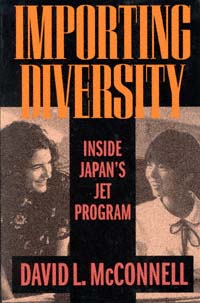 | Title: Importing diversity: inside Japan's JET Program Author: McConnell, David L 1959- Published: University of California Press, 2000 Subjects: Anthropology | Japan | Politics | Education Publisher's Description: In 1987, the Japanese government inaugurated the Japan Exchange and Teaching (JET) program in response to global pressure to "internationalize" its society. This ambitious program has grown to be a major government operation, with an annual budget of $400 million (greater than the United States NEA and NEH combined) and more than six thousand foreign nationals employed each year in public schools all over Japan.How does a relatively homogeneous and insular society react when a buzzword is suddenly turned into a reality? How did the arrival of so many foreigners affect Japan's educational bureaucracy? How did the foreigners themselves feel upon discovering that English teaching was not the primary goal of the program? In this balanced study of the JET program, David L. McConnell draws on ten years of ethnographic research to explore the cultural and political dynamics of internationalization in Japan. Through vignettes and firsthand accounts, he highlights and interprets the misunderstandings of the early years of the program, traces the culture clashes at all levels of the bureaucracy, and speculates on what lessons the JET program holds for other multicultural initiatives.This fascinating book's jargon-free style and interdisciplinary approach will make it appealing to educators, policy analysts, students of Japan, and prospective and former JET participants. [brief] Similar Items |